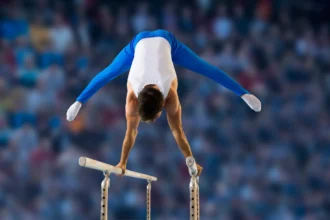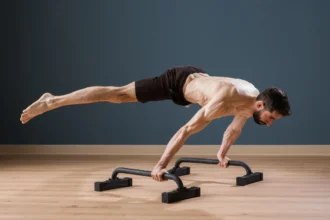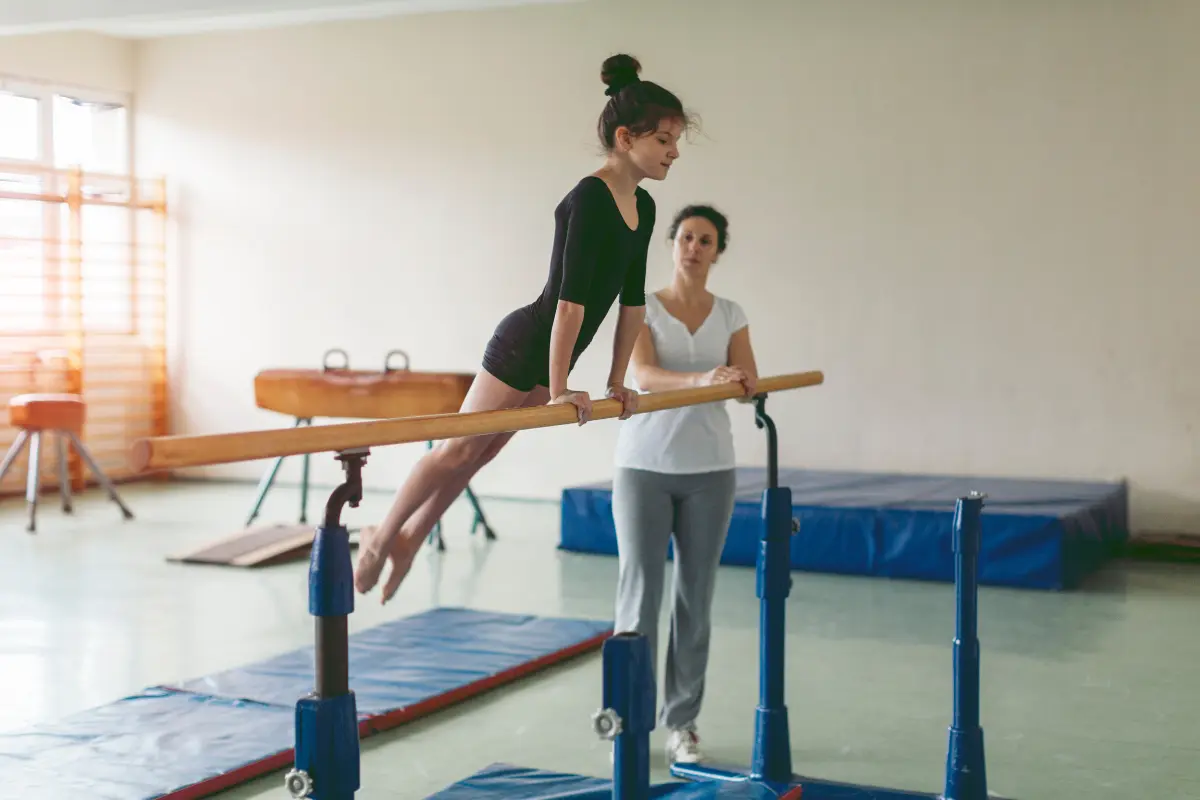Bar exercises are an important part of gymnastics training, helping athletes build strength, flexibility, and control. For beginners, learning basic bar skills is key to creating a strong foundation for more advanced moves.
In this article, we’ll cover five essential bar exercises for beginners. These fun and engaging exercises will help young gymnasts develop the skills they need to succeed and progress in their training.
1. Pike Hang
The Pike Hang is an excellent starting point for beginners, focusing on core strength and improving body awareness. In this exercise, gymnasts hang from the bar in a pike position, with their legs straight and toes pointed. It not only works the core but also engages the legs and helps with developing control in the hanging position.
How to Perform the Pike Hang:
- Grab the Bar: Begin by hanging from a horizontal bar with your arms fully extended. Your palms should face away from you (overhand grip), and your hands should be slightly wider than shoulder-width apart.
- Lift Your Legs: Pull your legs up to your chest, creating a pike position where your legs are straight and together. Keep your toes pointed.
- Hold the Position: Focus on maintaining a strong core and keeping your body as tight as possible. Hold the position for a set amount of time, typically 3-5 seconds for beginners, depending on age and ability.
- Lower Slowly: Lower your legs back to a straight hanging position with control.
Benefits:
- Core Strength: This exercise builds abdominal strength, helping gymnasts stabilize their bodies in various positions.
- Leg Control: Lifting the legs into a pike position engages the hip flexors and helps with leg strength and control.
- Posture: The pike hang also helps improve body posture and body awareness during other bar exercises.
2. Skin the Cat
The Skin the Cat exercise is fantastic for developing shoulder flexibility and upper body strength. This exercise involves rotating the body upside down on the bar, with the feet passing inside the hands. It also helps gymnasts become more comfortable with being inverted, which is an essential skill for many gymnastics movements.
How to Perform the Skin the Cat:
- Hang from the Bar: Begin by hanging from the bar with a firm grip and arms fully extended.
- Bring Feet to Hands: Pull your knees up and over the bar, guiding your feet inside your hands.
- Rotate Your Body: Continue rotating your body over the bar until you reach an inverted position, with your feet going all the way around.
- Return to Starting Position: Slowly return to the starting position by reversing the motion, keeping your shoulders engaged throughout the movement.
Benefits:
- Shoulder Flexibility: Skin the Cat enhances shoulder mobility and flexibility by requiring the gymnast to rotate and stretch the shoulders.
- Core Engagement: This move also works the core, as gymnasts need to control the rotation and stabilize the body while upside down.
- Confidence Upside Down: The exercise helps children build confidence in being inverted, which is important for more advanced gymnastics skills.
3. Hot Dog
The Hot Dog exercise helps develop strength in the arms and stomach while improving coordination and body control on the bar. In this exercise, gymnasts hook their feet over the bar, then pull their chin up toward the bar repeatedly. This movement strengthens the core, arms, and helps with overall body awareness.
How to Perform the Hot Dog:
- Hang Sideways on the Bar: Start by hanging sideways on the bar with your arms extended.
- Hook Your Feet: Hook your feet over the bar, keeping them tight together.
- Pull Your Chin Up: Pull your chin toward the bar using your arms and core. Repeat this motion for a set number of repetitions (for example, 4 times for a 4-year-old).
- Control the Movement: Focus on using your stomach and arm muscles to pull your body toward the bar while keeping your legs engaged and steady.
Benefits:
- Arm and Core Strength: This exercise works both the upper body and core, helping to develop the necessary strength for other bar skills.
- Coordination: The sideways hanging position and chin-up movement improve coordination and control of the body.
- Bravery: It also encourages gymnasts to be brave and use their whole body on the bar, preparing them for more advanced moves.
4. Pullover
The Pullover is a foundational gymnastics move that helps gymnasts develop upper body strength and core control. This skill is often used as a stepping stone to more advanced skills, such as casting or muscle-ups. It involves pulling the chin up to the bar and then lifting the hips over it, finishing with straight legs and pointed toes.
How to Perform the Pullover:
- Hang from the Bar: Start by hanging from the bar with a firm grip and arms extended.
- Pull Your Chin to the Bar: Pull your chin up toward the bar, engaging your arms and core.
- Lift Your Hips Over the Bar: Once your chin is over the bar, lift your hips up and over it, keeping your legs straight.
- Finish with Straight Legs: Complete the movement by pushing away from the bar and finishing in a front support position with your arms straight and legs extended.
Benefits:
- Upper Body Strength: The pullover strengthens the arms, shoulders, and back muscles, which are vital for bar routines.
- Core Engagement: The movement requires strong core engagement to lift the hips over the bar and maintain control.
- Foundation for Advanced Skills: The pullover is a crucial skill for progressing to other advanced bar moves, such as casting and back hip circles.
5. Back Hip Circle
The Back Hip Circle is a more advanced bar skill that combines a pullover with a backward swing of the legs. It helps improve shoulder strength, flexibility, and coordination. This move is often used as a precursor to more complex skills like releases and dismounts.
How to Perform the Back Hip Circle:
- Perform a Pullover: Start by executing a pullover, bringing your chin to the bar and lifting your hips over it.
- Cast and Swing Your Legs: After the pullover, push your body away from the bar slightly (casting), and then swing your legs backward.
- Complete the Backward Swing: As you swing your legs backward, rotate your body around the bar in a circular motion.
- Finish with Strong Arms: Finish the movement by pushing away from the bar and coming to a front support position with your arms straight.
Benefits:
- Shoulder Strength and Flexibility: The back hip circle helps develop strong shoulders and improves flexibility in the upper body and hips.
- Coordination and Control: It improves coordination and body control as gymnasts learn to combine a pullover with a backward leg swing.
- Advanced Skill Preparation: This move is a building block for more advanced bar routines and dismounts.
The skills mentioned above help young gymnasts build a solid foundation in these areas, ensuring they have the strength and control necessary for more complex routines. Starting with these basic bar skills allows children to progress at their own pace while building the strength and confidence needed to master higher-level gymnastics.





